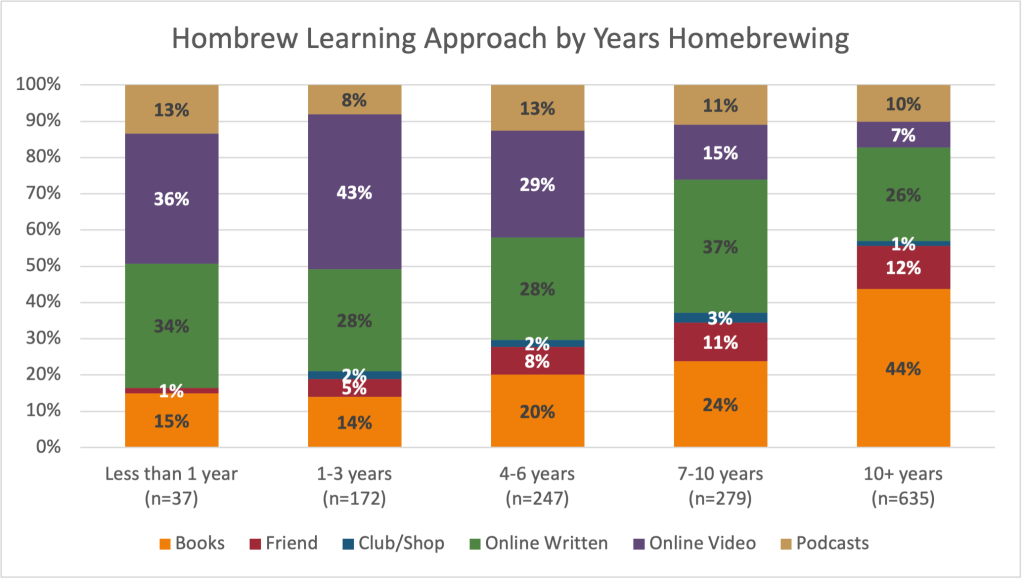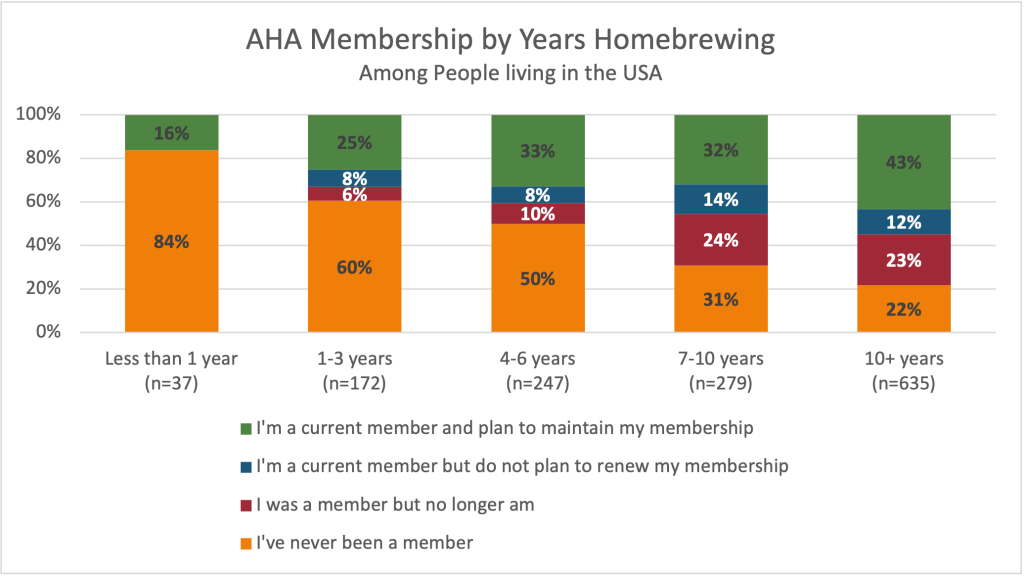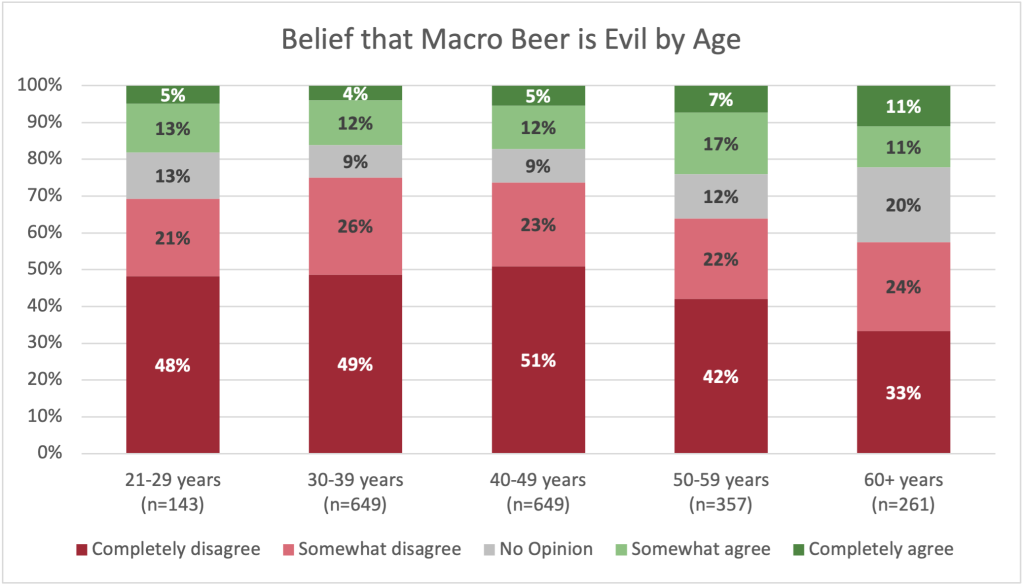Authors: Marshall Schott & Andrew Bromley
Massive cheers to everyone who took the time to complete our 2024 General Homebrewer Survey! In what we hope is a sign of a turnaround in this hobby, and perhaps craft beer in general, we had close to 1,000 more respondents this year compared to last year’s survey. As a reminder, our primary goal in collecting this data is to keep track of changes and trends in homebrewing, which serves several purposes, one of which is shining a light on areas the industry should be focusing on.
While some of the data has remained largely unchanged year-over-year, we found the following bits rather interesting.
- Brewfather is growing rapidly in popularity with 44% of respondents identifying it as their recipe design software of choice
- While all-in-one electric setups increased in popularity consistently from 2018 through 2022, this data suggests their adoption has tapered off a bit
- Most people who ferment with lager yeast cold (n=929) don’t ferment under pressure (17% under pressure); however, those who use lager yeast warm (n=365) are about equally as likely to ferment under pressure (48%) as those who don’t
- Compared to 2 years ago, fewer people report brewing with unfiltered tap water, while more people are using RO water (32%), whether home or store-bought
- Daily consumption of homebrew beer appears to be down a bit based on the increase in folks reporting they drink none in a given day
- Considering source of homebrewing education, books continue to trend downward for newer brewers, who tend to prefer online videos and websites; interestingly, the older generation of brewers was also more likely to learn from friend
- Those who have been brewing longer are more likely to have been a member of the American Homebrewers Association and intend to continue being a part of it
- There appears to be a positive correlation between age and negative views of macro beer, while younger respondents appear to be at least marginally more okay with Big Beer
Bearing in mind these findings represent a relatively small slice of the full homebrewing pie, particularly those who follow Brülosophy, but there’s a good likelihood certain aspects can be generalized. As has been the case in all past years, the typical homebrewer is a white, middle-aged dude who makes a decent income, owns their own, and likes hoppy styles.
Yet again, we received a few embarrassingly immature responses from people who clearly can’t tolerate the fact people who aren’t like them exist in this world. Despite the fact these obviously insecure and pathetic folks made up a tiny portion of the total response base, I’m hopeful the good of us can overpower their bullshit perspectives, though as I think many of us have witnessed in recent years, the voices of the ugly tend to be obnoxiously loud, which I suspect may detract some people from this hobby. What to do about this? I wish we had the answers.
This annual survey wouldn’t be possible without the assistance of Andrew Bromley, who spends time analyzing the data and putting it together in a way that’s easy to read and understand. Similarly, there wouldn’t be any data if it weren’t for all you brewers out there who took the time to complete this survey. Thank you for helping us get a clearer idea of what the modern homebrewer looks like!
If you have any thoughts about these survey results or suggestions for future surveys, please do not hesitate to share them in the comments section below!
Support Brülosophy In Style!
All designs are available in various colors and sizes on Amazon!
Follow Brülosophy on:
FACEBOOK | TWITTER | INSTAGRAM
If you enjoy this stuff and feel compelled to support Brulosophy.com, please check out the Support page for details on how you can very easily do so. Thanks!
















8 thoughts on “2024 General Homebrewer Survey Results”
Interesting info, and kudos to Andrew for his beautiful charts! What do you think is driving the growth in the number of people brewing mead?
I think it’s seltzer. Mead has a similar lighter, less heavy taste and appeals to those who are conditioned to like seltzer but are tired of low-flavor drinks, and want something gluten free. I know I always bring two growlers of meads to neighborhood parties and often run back for refills. They are especially popular with the ladies at the parties.
Thank you for the insight, that completely makes sense…. Looks like it’s time to try brewing a batch of mead.
Cheers
Thanks for a great survey and all the work y’all put into it, et al…. The most interesting part, for me, are the beer styles data. It explains why it’s getting difficult to find my favorite styles at local breweries. On a side note, it is my opinion the religion and sexuality info is unnecessary. I don’t care what you do in the privacy of your home or to exercise your spirituality, and in this day and age I feel it triggers some people and divides us even in the ranks of the brewing community. Just my $.02……
I appreciate the survey and all the work you guys put in. Don’t be overly disappointed in the few bad actors who responded inappropriately. Always going to be a few. To put things into perspective, read Erik Larson’s new book, The Demon of Unrest, about the lead up to the US Civil War. Trust me, we’ve had far worse bad actors in our history.
I just started homebrewing, and found this survey interesting and fun. I’m an old white dude who owns a home and loves hoppy styles, so my input wouldn’t have skewed the data much. The penultimate paragraph stole the show! I had to read it aloud to my wife, and we had a good laugh.
I would sure like a podcast episode of Jersey and Tim reading the responses from the assholes. Those guys, with a few beers in them, would provide a hilarious take on otherwise pathetic comments. Keep up the great work, guys! Brulosophy is awesome.
Any insights into how many who marked being in a local homebrew club regularly attend meetings and events with them? I see a fair number of people list our local club when entering competitions, but they are never at meetings/events (so far seemingly [reasonably] due to family/work/other obligations).
I think a question about level of participation in local clubs would be insightful for leaders of all clubs